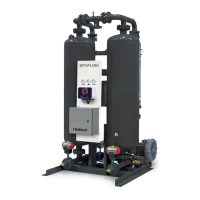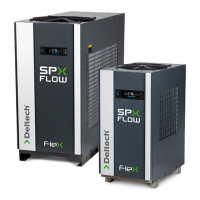2
3.0 Description
3.1 Function
Blower purge type regenerative dryers are an economi-
cal and reliable way to dry compressed air to dew points
below the freezing point of water. Desiccant dryers lower
the dew point of compressed air by adsorbing the water
vapor present in the compressed air onto the surface of
the desiccant. Adsorption continues until equilibrium is
reached between the partial pressure of the water vapor
in the air and that on the surface of the desiccant.
These dryers continuously dry compressed air by using
two identical towers, each containing a desiccant bed.
While one tower is on-stream drying, the other tower is
off-stream being regenerated (reactivated, i.e. dried out).
The towers are alternated on- and off-stream so that dry
desiccant is always in contact with the wet compressed
air. In this way a continuous supply of dry air downstream
of the dryer is possible. The switching from one tower
to the other is controlled by a solid-state controller on
either a xed time basis (standard) or a demand basis
(optional).
When a tower is placed off-line, it is slowly depressur-
ized and the desiccant is regenerated. First, a blower
draws in ambient air which is heated. The heated air
ows through the desiccant bed, desorbs the moisture
from the desiccant, and carries the desorbed water out
of the dryer. The blower and heater are turned off when
the desiccant bed is fully heated. When congured for
cooling, a portion of the dry compressed air is diverted
from the main air ow and throttled to near atmospheric
pressure. This extremely dry, low pressure air passes
through the hot off-line tower, partially cooling the desic-
cant bed and reducing the dew point spike after tower
change over. At the end of the cooling stage, the tower
is repressurized to full line pressure. This prevents desic-
cant bed movement and downstream pressure loss when
the tower goes back on-line.
4.0 Installation
4.1 System Arrangement
Install the dryer downstream of an aftercooler, separator,
receiver, and high-efciency oil-removing lter(s) so that
the dryer inlet air is between 40°F (4.4°C) and 120°F
(49°C) and contains no liquid water or oil. Liquid water
and/or inlet air temperatures above 100°F (37.8°C) can
reduce drying capacity. Contact your local distributor
for information on proper dryer sizing at elevated inlet
air temperatures.
Adequate ltration is required upstream of the dryer in
order to protect the desiccant bed from liquid and solid
contamination. Use an Air Line Filter in systems sup-
plied by a non-lubricated (oil-free) air compressor. In
systems supplied by a lubricated air compressor, use a
High Efciency Oil Removal Filter. A coarser lter will
be required upstream of the Oil Removal Filter if heavy
liquid or solid loads are present.
To ensure downstream air purity (prevent desiccant dust
from traveling downstream) adequate ltration down-
stream of the dryer is required. A High Temperature
Afterlter, typically rated at 450°F (232°C) operating
temperature and capable of removing all desiccant nes
1 micron and larger should be installed at the dryer outlet.
DANGER — This dryer must be tted with a high
efciency coalescing lter and liquid drainer that is
maintained properly. Failure to do so could result
in an in-line re.
WARNING — The afterlter, if installed, must be rated
for 450°F (232°C).
4.2 Ambient Air Temperature
Locate the dryer under cover in an area where the ambi-
ent air temperature will remain between 35°F (2°C) and
120°F (49°C).
NOTE: If dryer is installed in ambients below 35°F
(2°C), low ambient protection requiring heat tracing
and insulation of the prelter bowls, auto drains and/
or sumps, and lower piping with inlet switching and
purge/repressurization valves is necessary to prevent
condensate from freezing. If installing heat tracing, ob-
serve electrical class code requirements for type of duty
specied. Purge mufers and their relief mechanisms
must be kept clear from snow and ice buildup that could
prevent proper discharge of compressed air.
4.3 Location and Clearance
Install the dryer on a level pad. Ensure the dryer is level
by grouting or shimming as necessary. Holes are provided
in the dryer base members for oor anchors. Securely
anchor the dryer frame to the oor. Allow 24 inches clear-
ance on all sides of the dryer for servicing. Provide ad-
equate clearance for prelter element, afterlter element
and heater element replacement. Provide protection for
the dryer if it is installed where heavy vehicles or similar
portable equipment is likely to cause
damage.
4.3.1 Blower Installation
(
Models 3200 through 4300 only)
NOTE: Field installation of the purge blower to the dryer
unit is required on model sizes 3200, 3600, and 4300.
Refer to Figure 3b for assistance in connecting the purge
blower to the dryer unit.
1. Align and install the purge blower skid to the dryer
unit utilizing the expansion joint provided (shipped
mounted to the purge blower). Use the mounting
hardware (nuts, bolts, ange gasket, etc.) provided
to connect the purge blower skid to the dryer unit.
Ensure the purge blower skid is level by grouting or
shimming as necessary. Holes are provided in the
purge blower skid base members for oor anchors.
Securely anchor the purge blower skid to the oor.

